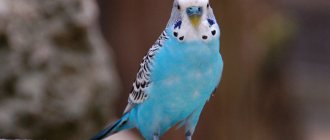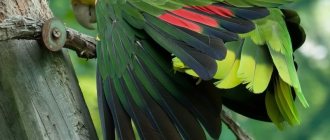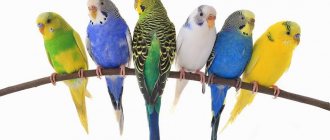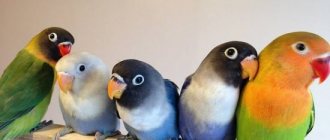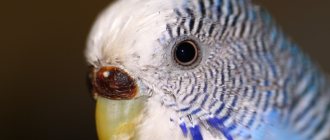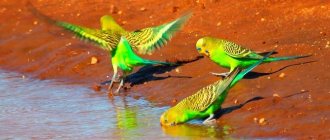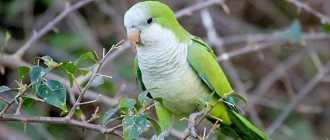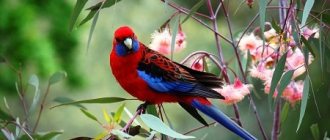Despite the apparent prevalence of exotic birds, only 5% of the population of Russia and other CIS countries decide to own a parrot.
Of course, over time the situation will improve for the better - after all, more and more poultry houses are appearing on the territory of our states, offering to purchase a cheerful and friendly feathered friend.
Lori parrots are unique birds that it is simply impossible not to fall in love with from the very first days of communication. Despite their exoticism, these bright pets perfectly find a common language with humans. A significant disadvantage of such contact parrots is their unusual way of feeding and the high level of requirements for their care.
Description and features of the lorikeet
A small, colorful member of the tree parrot family lives in Australia. It can often be found on the Solomon, Maluku, and Tasman Islands.
Appearance
Body length 27-31 cm, wingspan 16 cm, weight about 130 g. The head is bluish-purple. The front neck and belly are dark blue. There is a yellow stripe on the neck. The breast is red, with orange markings on the sides. Dark green plumage on the back, outer side of the wings and tail. The underparts and undertail are greenish-yellow. The beak is orange. The iris of the eyes of a female individual is orange-red, while that of a male is bright red.
Appearance of Lori parrot
Loria in the wild feeds on pollen, flower nectar, and juicy fruits. The tongue has a horny papilla, which is called a brush. It allows you to extract nectar and juice.
Intelligence and character
Laurie is a bright student. They remember both individual words and entire sentences. Their vocabulary can number more than fifty units of speech.
Friendly and curious. Parrots from the wild are not afraid of people. They flock to a treat, boldly sit on your shoulder, and give it to your hands. At the same time, they make noise and push if there are several of them. They are easy to tame. It takes a small amount of time to adapt to new conditions. After just a week, the cheerful parrot will become a participant in family affairs. He doesn't like being in a cage. He will quickly choose one family member as a friend and will pay a lot of attention to him.
Important! Loris love to play and are similar to little kittens.
Characteristics and learning ability of the parrot Lori
General characteristics
Birds in this family have many of the same qualities. They:
- brightly and richly colored;
- very playful;
- cheerful enough;
- quickly adapt to a new environment;
- have developed intelligence;
They have the same feeding method due to the presence of a brush on the tip of the tongue. The catchy and bright plumage successfully helps them camouflage among flowers, grasses, and shrubs, where the birds look for food.
Price
One of the most significant disadvantages of the bright Lori parrot is its high cost. For one bright, talkative and very friendly handsome man, you will have to pay up to 30,000 rubles. Despite the price factor, contact birds of this species are common almost everywhere - they are present in any more or less large pet stores and shopping ornithological centers. You can also buy bright Lori by advert - using modern online platforms like Avito.
Previous
All types of owl parrot kakapo and its features
Next
All types of Venezuelan Amazon and its features
Kinds
Loris parrots form a large family. Although it has already been said above about the species and subspecies numbers, ornithologists are still arguing over these figures.
Varieties of the Australian Lory parrot
The following lorises are considered the most popular:
- white-backed;
- brilliant;
- maiden;
- rainbow;
- musky;
- red;
- New Guinea;
- decorated;
- wedge-tailed
- lori-gua;
- hermit, etc.
Rainbow
Often found among pets. The multi-colored color with many shades attracts the attention of breeders.
Rainbow loris
The lorikeet's head is lilac, its abdomen and neck are blue, and its neckband is yellow. The breast is red, the sides are orange. The back and wings are bright green, the tail is light green with yellowish tint. The iris is bright red. Agree, such a bird will decorate any home.
They live in tropical forests and city parks on the east coast of Australia. Therefore, they are not afraid of people and can be completely tame. They feed on berries, tree fruits, seeds, and flowers. True, unlike other parrots, they do not live long - about 20 years.
Brilliant
A representative of small birds. It barely reaches 30 cm. It usually lives in flocks of 15-30 birds and lives on the banks of rivers in New Guinea, Melanesia, Indonesia, and inhabits the savannah. The genus includes 4 species, 8 subspecies. Among this diversity, the cardinal lory stands out. Bright red feathers surprise with their tints. There are also black, brown and red-fronted shiny lorises.
These parrots have a hard time surviving captivity. They have a hard time acclimatizing and getting used to new living conditions. They do not tolerate a change in diet well - new types of food negatively affect the digestive system of parrots.
Brilliant view of a loris parrot
Red
Looks very elegant. Quite similar to the cardinal lory, as it also has bright red plumage at the base, but differs in many splashes of blue, black and/or purple. The birds reach a length of 30 cm. The beak is orange, the paws are gray, and the eyes are brown. Both males and females have the same feather color.
The following species are found in nature:
- blue-red (endangered, numbers sharply declining);
- scaly red (interspersed with violet-blue);
- red (includes two more subspecies);
- blue-eared red (very sociable and active);
- black-winged red (due to human intervention in nature and changes in natural habitat, it is in danger of extinction);
- half-masked red (lives exclusively in mountainous and wooded areas).
Tell me some ways to clean up the dirt behind the loris.
Lories are notorious for being extremely dirty. Of course, all birds make dirt to one degree or another. They just do it differently. As for the lorises, it’s not a matter of husks all over the house or white powder on dark furniture, as is usually the case if you have a brown gray or a cockatoo.
Loris feces have a liquid or semi-liquid appearance. They are easily washed off with water and are easier to clean from furniture than the sticky green feces of other parrots. Not all lorises “spray” from their cage. Many of them spend most of their time on perches, like other parrots, and their feces fall to the bottom of the cage.
But if the loris hangs on the wall of the cage, then this is already a problem. But in order to solve this issue, a lot of inventive ways have been invented. Some people wrap the cage in a material like oilcloth or a bath curtain, but the lorises can chew it. It is better to place removable acrylic panels on the sides of the cage. It is better to use oilcloth to protect the floor under and around the cage from drops. Of course, you will need to use your imagination, but the loris are worth it. (If you think lorises are assholes, get a toucan!)
Habitat in the wild
I have already said above where lore-crowned parrots live. They are also found in Indonesia, New Guinea and the Philippines. The birds form a group, after which they look for a suitable place in forest thickets or mountain ranges.
Habitat of a parrot in the wild
Birds love to fly and climb tree branches, clinging tightly with their talons and beaks. Nests are built in hollows, sometimes (some species) in empty termite mounds.
Foraging for food takes birds a lot of time. Collecting pollen and nectar is a labor-intensive process.
The noise and scream of the feathered family can be heard from afar. They are very loud birds, their voices are harsh.
Lorises love to swim, so they often settle near bodies of water.
Common diseases
If a bird lives in optimal conditions and also eats properly, then it develops a strong immune system, so it is resistant to various pests or diseases. If the conditions are incorrect, various health problems may arise.
The most popular diseases include:
- self-plucking, which usually occurs in parrots that spend a lot of time in a cage, so they begin to get bored;
- obesity, which appears due to improper nutrition or lack of physical activity;
- constipation caused by poor quality food or too hard food;
- salmonellosis resulting from poor nutrition;
- aspergillosis, represented by damage to the respiratory system by molds, and they usually appear from contaminated food;
- tuberculosis, the pathogens of which enter the bird’s body through airborne droplets, and there are no symptoms of the disease at the initial stage, and this disease cannot be cured;
- helminthiasis that occurs due to poor quality nutrition or lack of timely cleaning of the cage;
- down feather eaters, which make holes in feathers and also negatively affect the nervous system of birds.
If the behavior of a parrot changes dramatically and loses appetite or interest in toys and training, then you should urgently contact a veterinarian, as this indicates health problems.
Care and maintenance
Birds were first introduced to Europe in the 1800s. Among them there are quite intelligent and quick-witted individuals capable of very accurately and verbosely imitating human speech. At home, with proper care, they can live quite a long time.
In order for your pet to always make you happy, you need to create maximum comfort for it and take care of proper nutrition.
Keeping a parrot at home and caring for it
Cell
Parrots of the Loriidae family love space. For them you need to buy a roomy house. His choice should be taken with great responsibility. This place should become a favorite and comfortable place for your pet. Necessary conditions for the cage:
- parameters no less than 150x70x70 cm;
- rods with a metal base;
- equipment: perches, drinking bowls, feeders;
- A swing, a bathtub, toys, and a mirror will not be in the way;
- built-in plywood house for overnight stay.
A pull-out tray is installed at the bottom. This makes cleaning easier. Special sand is poured, several layers of paper are placed and covered with a net on top. This is due to the fact that all parrots have liquid droppings due to their feeding habits. It's difficult to clean. A simple device in the form of an exhaust tray will help the owner cope with cleaning faster and better.
Cell Selection Options
Important! Place the cage in a place where there are no unpleasant odors or loud, sharp sounds. This will protect the birds from stress, which in turn can lead to discomfort and intestinal problems.
Diet
If you are planning to keep a lorikeet at home, you should be aware that in the wild they feed on nectar and pollen. In captivity, they must be accustomed to grains. To do this, it is recommended to first prepare a watery slurry.
What to include on the menu?:
- liquid porridge with honey, jam;
- baby food;
- juice and pulp of exotic fruits;
- crackers soaked in sweet honey drink or tea;
- dandelion flowers, clover branches;
- dry cereals;
- mealworms and insects;
- special food for lorikeets.
Creating the right diet for a loris parrot.
A delicacy for keeping cages is branches of fruit trees with open buds. In summer, birds are fed with flowers of horseradish, Jerusalem artichoke, sunflower, and apple trees. Crepes, daisies, licorice, and alfalfa are also edible for them.
Your daily diet should include fruits and vegetables. You can feed available foods:
- apples;
- pears;
- grapes;
- carrots;
- bananas;
- oranges.
Birds love freshly squeezed juices of watermelon, melon, and mango.
Experienced breeders recommend treating your pet with sprouted grains and oats.
Laurie. Lorikeet. Parrot. Voices of birds
Important! The amount of protein consumed should not exceed 25% of the weight of the daily diet. Excess can lead to gout and disruption of metabolic processes in the lorikeet's body. Parrots are fed 2-3 times a day in small portions.
Hygiene and water procedures
Before buying a loris, think about whether you are ready to endure unpleasant squeaking cries and constant dirt. Some birds manage to splatter not only the bottom of the cage with droppings, but also all the objects around them. It seems that the bird deliberately complicates the life of its owner. The bird house will need to be constantly cleaned and washed.
Lorikeets are inhabitants of the tropics. The optimal room temperature should be maintained at 18-25 C. Daily bathing is advisable. Water temperature is 30-35 degrees.
Flight, training and games
When buying a parrot you will have many problems. Patience and only patience will help you cope with them.
Lory
Before you start flying training, you need to make friends with your pet. He must gain trust and mutual understanding with you, and adapt to new conditions.
The lorikeet should not be afraid of you. Stand next to him for a long time, do not shout at him, do not make sudden movements.
While cleaning, talk to your pet and call him by name. When the parrot gets used to it and eats calmly in your presence, move on to the next stage.
Get used to your hands. Slide them into the cage and hold them motionless for 3-4 minutes. At first, the bird will shy away and hide in the far corner. Gradually he will get used to it. After this, teach the parrot to move onto the perch.
Exercise every day, move the bar, encouraging your pet to sit on your hand. As soon as you succeed, start teaching the bird to peck from your hands.
And now you already have everything listed above. Now you can move on to learning to fly. There are also some nuances here. First teach your pet to fly into the cage. Place your pet on your finger and move your hand 10-15 cm from its home. Release the parrot and it will fly into the cage. Gradually increase the distance. The bird will quickly learn to return back to its home.
Funny parrots (Lori)

